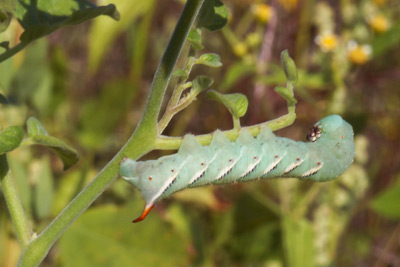Plant mating styles influence defense evolution
By Krishna Ramanujan

When it comes to mating, plants do it in many ways. On one end of the spectrum, there are plants that self-fertilize or mate with relatives (inbreeders); on the other are plants that mate with nonrelatives (outcrossers). The two types of mating styles have evolved very different defense strategies, Cornell researchers have found.
Inbreeders’ defense systems become activated only after their leaves have been eaten or damaged. Outcrossing species, on the other hand, have defense systems that are always turned on.
The study of 56 species of nightshade was published online Feb. 20 in the Proceedings of the National Academy of Sciences.
“The question of how inbreeding and outcrossing mating systems should influence the evolution of defenses has never been answered before at such a broad scale,” said Stuart Campbell, the paper’s lead author and a postdoctoral researcher in the lab of study co-author André Kessler, Cornell associate professor of ecology and evolutionary biology.
One implication of the defense system that activates only when needed, as with inbreeders, is that these plants have advantages for colonizing new areas.
“There is an association between the dispersal or invasiveness of a species and self-fertilization,” said Campbell.
Plants that self-fertilize or inbreed do not require large populations to reproduce and colonize new areas. At the same time, if a plant species moves to a new area, it likely leaves behind many of its enemies. Without the constant threat of those enemies, inbreeders can save energy that might have gone to defense by employing a system that turns on only after being eaten. For example, some plants form a toxic chemical when their leaves get damaged.
Meanwhile, outcrossers that depend on larger populations to reproduce may have an evolutionary advantage by maintaining constant chemical and structural (i.e., thorns, thick hairs) defense systems against enemies that are drawn to the crowds of plants.
In the nightshade family of up to 4,000 species, the common ancestor was an outcrossing species, though the shift to inbreeding has independently occurred within the family more than 60 times in the course of evolution. The researchers examined the defenses of more than 50 wild species of nightshade (Solanaceae) including wild tobacco, pepper, tomato and potato species.
Campbell and Kessler identified 25 pairs of plants where each pair represented a species that had independently evolved an inbreeding reproductive strategy and an outcrossing relative. These pairings were set up with controls and experimental plants.
The pairs of experimental plants were exposed to tobacco hornworm caterpillars (Manduca sexta) that prefer to feed on nightshade. After 20 percent of each plant was eaten, leaves were removed both from controls and the experimental plants. The researchers found that on the undamaged control plants, caterpillars weighed less or died more often on outcrossing species. Caterpillars also performed poorly when they ate leaves from plants that had previously been eaten. But this induced effect was dramatically greater for inbreeding plants.
“We had known that the sex lives of plants can influence herbivores, but this is the first study to look across the evolutionary history of a plant family and examine the consequences of mating systems for defense evolution,” Campbell said.
The study was funded by the National Science Foundation, Natural Sciences and Engineering Research Council of Canada, the Grace Griswold Research Endowment and the Andrew Mellon Foundation.
Media Contact
Get Cornell news delivered right to your inbox.
Subscribe